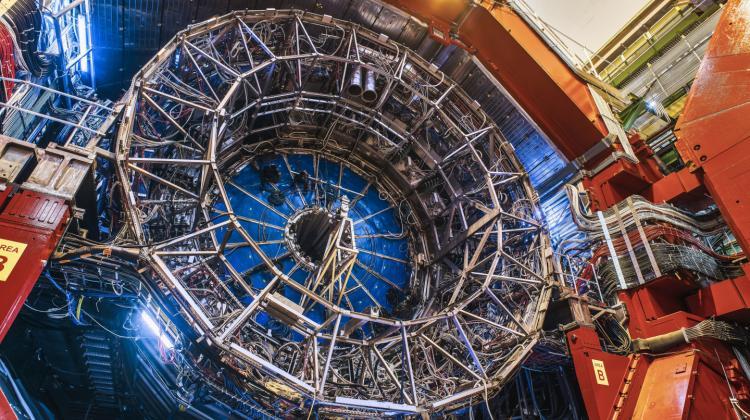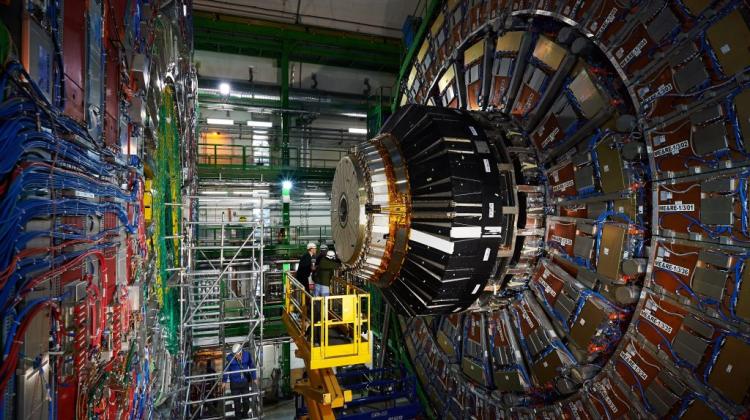ALICE shows that free charm quark has mass
 ALICE detector at CERN. Credit: Julien Ordan, CERN
ALICE detector at CERN. Credit: Julien Ordan, CERN
Do you have a problem finding out how much you really weigh, because the bathroom scale shows a slightly different result every time you step on it? Scientists from the ALICE experiment at CERN determined the mass of the charm quark - an elementary particle that weighs about half a million billion billionth part of gram and is released only for a fraction of a second at huge temperatures in the collisions of particles inside the Large Hadron Collider.
Ordinary matter we deal with every day, including protons and neutrons that which make up atoms, is built of up (U) and down (D) quarks. But these are not all quarks that exist in the universe. Even more massive quarks have described: strange (s), charm (c), true (t) and beauty (b) quarks. Those, however, are much more difficult to observe.
This time, scientists from the international ALICE collaboration at the Large Hadron Collider (including Polish researchers) focused on the charm quark found in D mesons. They decided to investigate how the charm quark behaves when it is completely alone.
LONELINESS IN THE QUARK WORLD
Loneliness in the world of quarks is completely unheard of: these elementary particles love company so much that in a split second from their birth they are trying to find a partner (or two, or even more). And in this case, the fraction of a second is a hundred thousand billion billionth part of a second (10^-23) - that is how much time a charm quark in LHC needs to find a pair.
Although the properties of hadrons (composite subatomic particle made of quarks) are well researched, it has not been entirely clear what can be said about quarks when they are completely alone.
It is not a trivial issue because the properties of quarks in a composite (hadron) are completely different from properties of the same quarks, but alone. For example, not only the masses of its component quarks add up to the mass of a hadron, but also the energy of interactions between them (the famous Einstein equation that shows the equivalence of mass and energy).
To eliminate the phenomena that take place in a stable pair or three quarks from the equation, researchers designed an experiment that will allow to determine the properties of a charm quark in this short moment when it is looking for a partner. The publication on this subject appeared in Nature.
UNDER THE PARTICLE SHOWER
The challenge was to identify charm quarks looking for partners in a heavy shower particles formed in the Large Hadron Collider.
To remind: In the Large Hadron Collider at CERN near Geneva, particles accelerated to huge speeds travel in the 27 km long tunnel. When they collide with a stream of particles travelling in the opposite direction, huge energy is released. In this small, hot, dense bubble, exotic particles can form for a moment, which we do not observe in ordinary situations (but which, for example, form in stars or just after the Big Bang). These particles escape from the scene towards detectors, lose energy, form other particles or, for example, start a series of changes in other particles. By analysing data from the sensors, scientists try to recreate information about what happens in this bubble.
'ALICE can measure and identify these particles to the extent that we were interested in in the study of charm quarks', says the experiment participant Professor Adam Kisiel from the Warsaw University of Technology.
DEAD CONE
The dead-cone effect helped search the data from detectors and find information about the released charm quarks. According to theory, a charming quark seeking a partner would lose energy by emitting particles (gluons) in a specific manner: no particle escaping from this energy-losing quark leaves it in the direction of it flight, so a dead cone is forms that is not observed in the case of lighter quarks. This is an observation of one of the fundamental effects of strong interactions.
The publication in Nature confirms the experimental observation of such dead cones and the fact that thanks to them it is possible to get insight into the lonely moment of the charm quark's life.
'Our research is the most direct confirmation that free charm quarks have mass', says Dr. Łukasz Graczykowski. This mass is approx. 1,28 GeV/c2, i.e. around 2,29x10^-24 g. So it can be said that about half a million billion billion of such lonely quarks would weigh one gram. That is some precision in mass measurement!
Professor Marek Kowalski from the Institute of Nuclear Physics PAS adds, however, that directly observing a quark is impossible, because the quark itself does not exist as a free particle, one that we can measure in the detector. Observations are based on the analysis of properties of particles that formed from quarks and gluons. And that is a very difficult task.
STRONG INTERACTIONS
Polish participants of the experiment explain that this research is important because it confirms the findings of quantum chromodynamics. Professor Adam Kisiel reminds that in order to describe the functioning of the world, four interactions should be understood: electromagnetic, strong, weak and gravitational interactions. 'And quantum chromodynamics is a theory describing strong interactions, 1/4 of the world. So the fundamental question is whether the description we are using is correct'.
Professor Marek Kowalski clarifies where strong interactions are present. 'Atomic nucleus is a durable object, despite the fact that it consists of neutrons that have a zero electric charge and protons that have a positive charge. Therefore, there must be some stronger interaction between them than the electrostatic interactions - this is the strong interaction', he says. He explains that the subjects of this interaction are quarks and glutons are its carriers.
To confirm in practice how a strong interaction works, it is good to have experiments up your sleeve that allow to observe quarks in a free state for a moment.
That is the experiment conducted by ALICE.
WHO THE F... IS ALICE?
ALICE is one of the four largest detectors installed in LHC (next to CMS, ATLAS and LHCb). Polish scientists have participated in its operations since the very beginning in 1993. They participated in the construction of the detector, creating software, servicing, calibration, analysis and data visualization. 'This work takes such a long time that several generations of scientists take part in it. We three represent three generations', say Dr. Łukasz Graczykowski, Professor Adam Kisiel and Professor Marek Kowalski.
PAP - Science in Poland, Ludwika Tomala
lt/ ekr/ kap/
tr. RL
Przed dodaniem komentarza prosimy o zapoznanie z Regulaminem forum serwisu Nauka w Polsce.



















